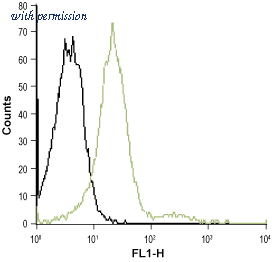产品简要
公司名称 :
Alomone Labs
产品类型 :
抗体
产品名称 :
Anti-Human CXCR2 (extracellular)-ATTO Fluor-488 Antibody
目录 :
ACR-012-AG
规格 :
1 X 50 mcl
价格 :
735美元
克隆性 :
多克隆
宿主 :
domestic rabbit
共轭标签 :
ATTO 488
反应物种 :
人类
应用 :
流式细胞仪
更多信息或购买 :
图像
图像 1 :

Cell surface detection of CXCR2 in live intact Jurkat cells: Cell surface detection of CXCR2 in live intact Jurkat cells: Black line: Unstained cells. Green line: Cells + Anti-CXCR2 (extracellular)-ATTO Fluor-488 Antibody, (#ACR-012-AG), (5-10 µg/5x105 cells).
产品信息
SKU号 :
ACR-012-AG_1_50_mcl
ParentSKU :
ACR-012-AG
Taxonomy Node :
Primary Antibody>Extracellular>Labeled
Action :
Insert
产品名称 :
Anti-Human CXCR2 (extracellular)-ATTO Fluor-488 Antibody
产品描述 :
Anti-Human-CXCR2 (extracellular) Antibody (#ACR-012) is a highly specific antibody directed against an epitope of the human protein. The antibody can be used in western blot and indirect flow cytometry applications, and has been designed to recognize CXCR2 from human samples.
nAnti-Human CXCR2 (extracellular)-ATTO Fluor-488 Antibody (#ACR-012-AG) is directly labeled with an ATTO-488 fluorescent dye. ATTO dyes are characterized by strong absorption (high extinction coefficient), high fluorescence quantum yield, and high photo-stability. The ATTO-488 label is analogous to the well known dye fluorescein isothiocyanate (FITC) and can be used with filters typically used to detect FITC. Anti-Human CXCR2 (extracellular)-ATTO Fluor-488 Antibody is especially suited for experiments requiring simultaneous labeling of different markers.
Short Description :
A Rabbit Polyclonal Antibody to CXCR2 Chemokine Receptor Conjugated to the Fluorescent Dye ATTO-488
同义词 :
CXCR2, C-X趋化因子受体类型2, 白细胞介素-8受体b, IL-8R B, 白细胞介素-8rb, IL-8受体类型2, CD182
靶标名 :
CXCR2趋化因子受体
Primary Category (Old) :
G-Protein Coupled Receptors > Chemokine Receptors > Antibodies
标记/共轭标签 :
ATTO 488 (Green)
应用 :
FC, LCI
宿主 :
兔
克隆性 :
多克隆
抗体亚型 :
兔IgG
基因符号 :
CXCR2
反应物种 :
人类(试验)
同源 :
人类只有
靶标/背景信息 :
Chemokines (CHEMOtactic cytoKINES) are an important subgroup of the inflammatory cytokine family. More than fifty chemokines are expressed in mammalian cells and are characterized by their relatively small size (~70-90 amino acids), their conserved N-terminus and cysteine motifs. This group of proteins has been further categorized on the basis of the cysteine spacing in the motifs creating C, CC, CXC, and CX3C chemokine subfamilies1,2.
All fifty chemokines exert their effects through twenty different chemokine receptors, belonging to the superfamily of G-protein coupled receptors (GPCRs) suggesting a certain level of promiscuity among the different receptors. All chemokine receptors couple to the pertussis sensitive Gi protein leading to phospholipase C activation and adenylate cyclase inhibition3.
Chemokines were first identified by their ability to mediate leukocyte chemoattraction. Apart from regulating the migration of leukocytes, they seem to be major players during inflammation and immunity4-6. Indeed, chemokines could also be further classified as being inflammatory, as many chemokines are extensively upregulated in response to inflammation, or housekeeping important for the homeostasis of certain cell types. Inflammatory chemokines are responsible for recruiting immune cells to the inflamed region, and housekeeping chemokines, expressed in lymphoid or non-lymphoid tissues mediate the trafficking and targeting of cells7,8.
In general, chemokines and their receptors guide leukocytes to sites of infection/inflammation. However, cases of chronic inflammatory disease and tissue damage occur when there is excessive recruitment of leukocytes. They could also be involved in the pathogenesis of neurological diseases like multiple sclerosis and many inflammatory diseases like atherosclerosis and inflammatory bowel disease. Recently, chemokines and their receptors have been found to be involved in cancer metastasis, namely breast cancer1. The chemokine signaling also seems to be important for the communication between neural cells and the immune system, especially in the context of infection.
The CXCR2 receptor could mediate chemotaxis and degranulation of neutrophils along with CXCR1 via interleukin-8 (IL-8), a proinflammatory chemokine with the CXC motif9. In addition, in a model of arterial injury, CXCR2 can improve endothelial recovery, and also seems to be important in recruiting endothelial progenitor cells to injured vessels10. CXCR2 is activated by a plethora of ligands: GROa, b, g, neutrophil-activating peptide, granulocyte chemotactic protein-2 and keratinocyte derived chemokine (CXCL1). CXCR2 is expressed in different brain regions11, in the lung and spleen12 and other regions.
免疫原 :
合成肽
区域 :
细胞外
Loop :
细胞外, N末端
序列 :
(C)EDFNMESDSFEDFWKGED, corresponding to amino acid residues 2-19 of human CXCR2
序列文本 :
Peptide (C)EDFNMESDSFEDFWKGED, corresponding to amino acid residues 2-19 of human CXCR2 (Accession P25025). Extracellular, N-terminus.
Primary Size (Size+Units) :
1 X 50 mcl
浓度 :
1毫克/毫升
浓度 :
1毫克/毫升
缓冲液 :
磷酸盐缓冲液(PBS)
pH值 :
pH值7.4
防腐剂 :
1% BSA, 0.05% NaN3 (% of reconstituted antibody)
Additive(s) :
Reconstituted antibody contains phosphate buffered saline (PBS), pH 7.4, 1% BSA, 0.05% NaN3.
格式(液体/冻干) :
冻干粉末
纯化来源(杂交瘤细胞, 腹水 :
Affinity purified on immobilized antigen
储存温度 :
-20°C
UniProt数据库 :
P25025
储存和重组 :
Reconstitution: 1 X 50 mcl double distilled water (DDW), depending on the sample size. The antibody ships as a lyophilized powder at room temperature. Upon arrival, it should be stored at -20°C, as long as it is in its original form, it can last a minimum of 3 years this way. The reconstituted solution can be stored at 4°C for up to 1 week. For longer periods, small aliquots should be stored at -20°C. Avoid multiple freezing and thawing. Centrifuge all antibody preparations before use (10000 x g 5 min).
包装规格 :
1
产品规格/规格 :
50
单位 :
mcl
标价美国[美元] :
735美元
更多信息或购买 :
公司信息

Alomone Labs
Jerusalem BioPark (JBP), Hadassah Ein Kerem
P.O. Box 4287
Jerusalem 9104201
P.O. Box 4287
Jerusalem 9104201
info@alomone.com
http://www.alomone.com972-2-587-2202
公司总部: 以色列
Alomone Labs公司成立于1989年,在离子通道、GPCR及神经信号通路研究等领域占据全球领先地位。
